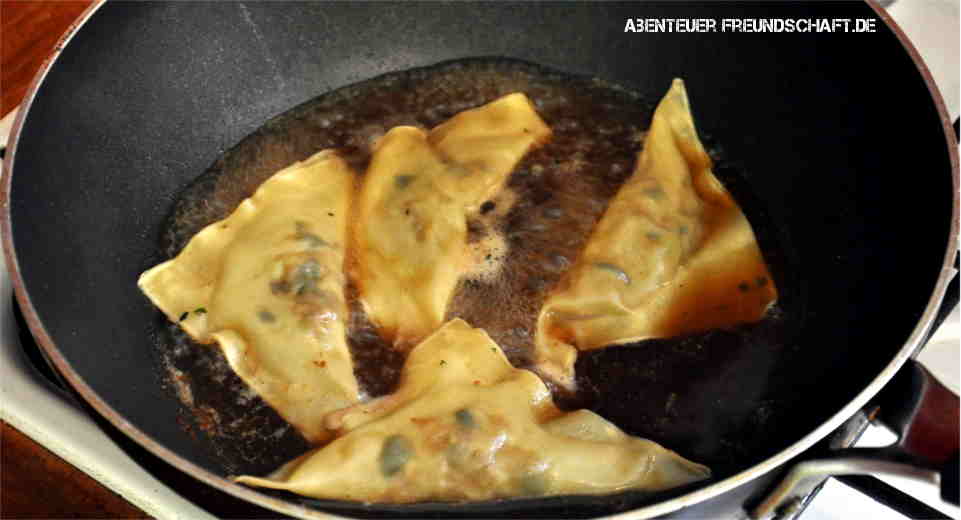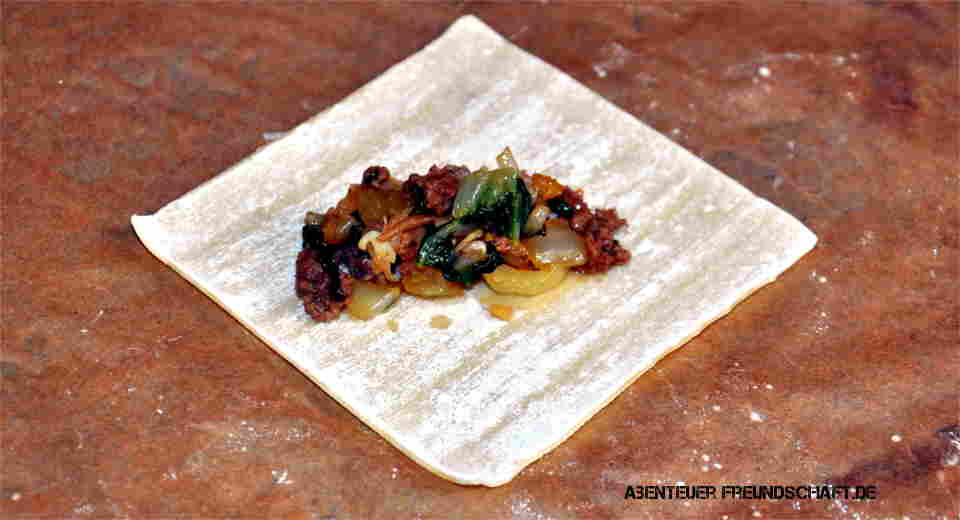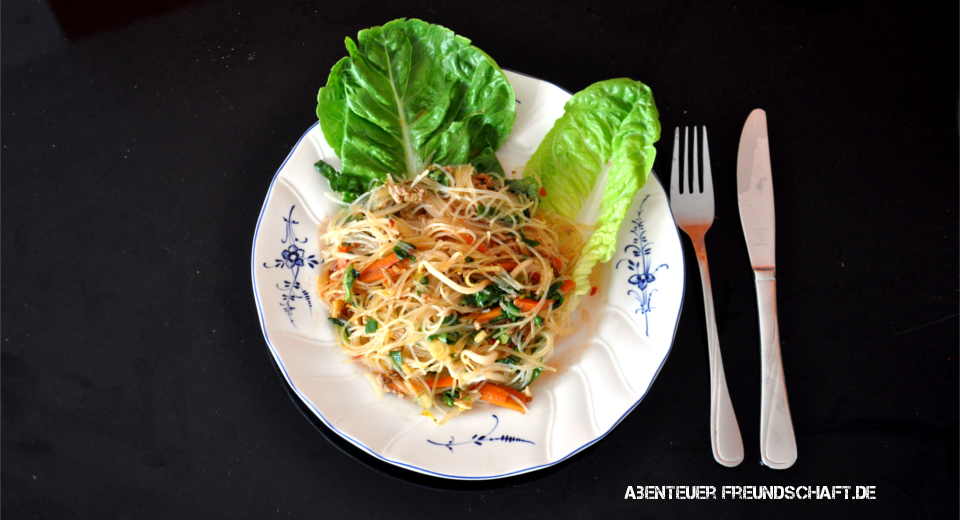This week it had over 30 degrees during the Korean Cooking Challenge! Even before the theme was clear, it was therefore sure: the food must taste best cold. This variation of Korean dumplings hit like a bomb.
- Korean Cooking Challenge: Crisp and sweet and sour
- Appetizer: Steamed Korean summer mandu sweet and sour
- Main course: crunchy lemony glass noodle salad
- Drink: Sweet and sour rice wine
When cooking with friends, we have a special kind of cooking battle: themed cooking. In this Cooking Challenge, two friends are given a theme that they try to implement in the best possible culinary way. The two friends who came up with the theme contribute the drink to the theme. When they feast together, they decide: how good was the team at cooking the theme this week?
1. Korean Cooking Challenge – the Theme
The theme was actually not difficult to implement. A crisp, fresh dish with lots of vegetables to match the hot temperatures and one before that a sweet and sour appetizer. Like many, I immediately associate the term “sweet and sour” with Asia. The cuisine of most Asian countries involves crunchy, briefly sautéed vegetables. So it was clear from the beginning: when cooking with thetheme crunchy and sweet and sour comes an Asian dish with a high proportion of fresh ingredients on the table..
Theme cooking is with us also always a Cooking Challenge, because we all have a high demand on the culinary result. In addition, we often try our hand at our own dishes that have never been cooked before. This time, I entered new culinary territory with my two dishes: my first Asian dumplings and my first lukewarm glass noodle salad were on the agenda. Since I am a big fan of Crossover Cooking, where you freely combine typical elements of cuisines from different countries, I decided not to cook a purely Thai or Korean food.
My first way led me to a large Asian supermarket. There I bought my Asian ingredients and spontaneously decided on the spot which crunchy vegetables I liked best for my Asian summer composition. It’s worth shopping there for the selection alone! The Asian supermarket also has many fresh herbs and exotic ingredients like banana flowers and the stink fruit, which you can’t get anywhere else.
2. Korean Cooking Challenge Appetizer: Korean Summer Mandu Sweet and Sour

Mandu are traditional Korean dumplings with a minced meat or vegetable filling. These dumplings can be steamed, sautéed, boiled or deep fried. In Korean restaurants, fried mandu are often served as an appetizer with soy sauce. In Asian supermarkets, you can buy packets of noodle patties called Wan Tan in the frozen food aisle. I used a package of 250g square noodle plates for four people. These noodle plates come in different sizes and shapes..
For the filling I decided to break with Korean tradition and not cook pure meat or vegetable pockets. In keeping with the theme, I also wanted the filling of my Korean mandu to be summery, crunchy and fresh. I opted for a mix of mixed ground beef, crunchy mung bean sprouts, pak choi, scallions and lemongrass. My summer mandu are steamed in a delicious broth..
Ingredients:
For summer mandu
- 250 g square wan tan dough sheets (frozen)
- 250 g pak choi
- 150 g mung bean sprouts
- 4 spring onions
- 2 cloves of garlic
- 300 g mixed minced meat
- 1 tbsp. peanut oil (alternative: sesame oil)
- 1 tablespoon soy sauce
- piece of ginger (approx. 1 cm x 1 cm x 1 cm)
- 1 stick of lemongrass
- salt, pepper, chili
- 3 tbsp. oil for frying
For the broth
- 1 liter vegetable broth
- 1 onion
- Piece of ginger (about 2 cm x 2 cm x 2 cm)
- 1 tbsp. soy sauce
Preparation:

The Wan Tan package from the Asian supermarket contains paper-thin noodle flakes that dry out quickly. That’s why it’s best to let them thaw under a damp cloth. Then you loosen the platelets with a knife and put the noodle plates in rows on baking paper..
For the filling you wash the vegetables, let them drain well and chop pak choi, mung bean sprouts and spring onions. In a bowl, season minced meat and finely chopped garlic together with soy sauce, peanut oil , ginger, lemongrass, salt, pepper and chili powder. In a pan, fry the minced meat in 3 tablespoons of oil until crumbly, then add the chopped vegetables and cook for about 5 minutes. If there is not enough liquid in the pan, add a little water. Now put a tsp of the filling on each half of the Wan Tan dough sheets. Brush the sides with water, fold the other half over the filling and press the sides of the dumplings..
In a pan, heat the broth with the chopped onion, ginger pieces and soy sauce and cook covered for 5 minutes. Now add the dumplings to the pan and cook gently for another 5 minutes until done. To the Mandu I have sweet and sour dip to dip in as well as soy sauce served..
Tip: Arrange the finished steamed pockets on the plates immediately – if you stack them on a serving platter, they will stick together and won’t separate well!
3. Main Course: Crunchy Asian Glass Noodle Salad

For the main course, I wanted a crisp, light salad with lots of fresh vegetables that would still be filling and harmonize well with the appetizer. So I chose the same basic ingredients as for the filling of the summer mandu and supplemented them with other fresh ingredients. Before it could start, I fought quite a long time with the meter-long, stubborn glass noodles from the XXL package to send them in boiling water bath… 😉
I timed the preparation so that the glass noodle salad is lukewarm when ready. This is how I think it tastes best, especially on hot summer days.
Ingredients:
- 200 g glass noodles
- 2 tablespoons peanut oil (or sesame oil)
- 200 g mixed minced meat
- 5 tbsp. broth (ideal: leftover Mandu broth)
- 9 tbsp. lemon juice
- 7 tbsp. fish sauce
- 2 tbsp. soy sauce
- 3 tbsp sambal olek (hot!)
- 2 cm piece of ginger
- 4 cloves garlic
- 2 small onions
- 4 spring onions
- 300 g pak choi
- 150 g carrots
- 2 stalks of lemongrass
- 3 tablespoons fresh coriander
- 100 g chopped peanuts
- Sugar
- 2 lettuce leaves per person
Preparation:
Bring water to a boil and pour the water over the glass noodles in a bowl. Let the glass noodles steep for about 10 minutes, then drain the remaining water and set the noodles aside.
Chop the lemongrass, onions and scallions into small pieces. Cut the pak choi into strips about 1 cm thick, cut the carrots into narrow sticks. Finely chop the garlic and ginger and fry them briefly in the pan together with the minced meat. Add the broth and cook until the meat is cooked through. The now only lukewarm glass noodles with scissors cut into pieces no more than 7 cm long..
Add the minced meat and chopped vegetables to the glass noodles and fold in. Combine the lemon juice, fish sauce, soy sauce and sambal olek in a bowl and pour over the glass noodles. Briefly toast the peanuts in a pan, mix with the chopped fresh coriander and add to the glass noodles. Fold in and season to taste. Through the lemon juice, the salad tastes sour fresh – who likes it a little sweeter can balance the acidity with a little sugar..
Place two lettuce leaves on each plate and arrange the glass noodle salad. Decorate with chopped peanuts and cilantro.
Tip: I actually wanted to garnish this salad with a tiger shrimp as a topping each. In the heat of cooking, I have but simply forgotten the crustaceans. Delicious it was anyway!
맛있게 드세요 or Good appetite for Your Korean Cooking Challenge! 🙂
You love to cook? We have more recipe ideas, for example, for quick pasta dishes, our France Cooking Challenge or a Italian three-course menu. However, at Greatime you will find many more indoor activities and general tips for activities with friends, with kids and with your partner.
Never miss any more tips and ideas from Greatime? Then follow us on Facebook and Instagram and subscribe to our newsletter! 😉
*There are affiliate links in this article. That means, if you order a product from amazon through one of these links, Greatime gets a small commission without the product becoming more expensive for you.


![Uber En Quot Ravensburger Escape Puzzle The Circle Paris Quot De Quot Exit Puzzle The Circle Paris Quot [Uber En="Review*of*Ravensburger*Escape*Puzzle*The*Circle*Paris" De="Rezension*des*Ravensburger*Exit*Puzzle*The*Circle*Paris"]](https://greatime.de/wp-content/uploads/2023/01/exit-puzzle-circle-paris.jpg)
![Uber En Quot Conundrums For Kids Quot De Quot Scherzfragen F R Kinder Quot [Uber En="Conundrums*for*kids*are*ideal*as*riddles*at*a*children's*birthday*party" De="Scherzfragen*für*Kinder*sind*ideal*als*Rätsel*bei*einem*Kindergeburtstag"]](https://greatime.de/wp-content/uploads/2019/08/scherzfragen-fuer-kinder-1.jpg)
![Uber En Quot Exit The Deserted Lighthouse Quot De Quot Exit Der Einsame Leuchtturm Quot [Uber En="The*game*EXIT*the*deserted*lighthouse*combines*puzzles*with*tricky*riddles*in*a*race*against*time." De="Das*Spiel*EXIT*der*einsame*Leuchtturm*verbindet*Puzzle*mit*kniffeligen*Rätseln*im*Wettlauf*gegen*die*Zeit"]](https://greatime.de/wp-content/uploads/2020/10/spiel-exit-der-einsame-leuchtturm-cover.jpg)